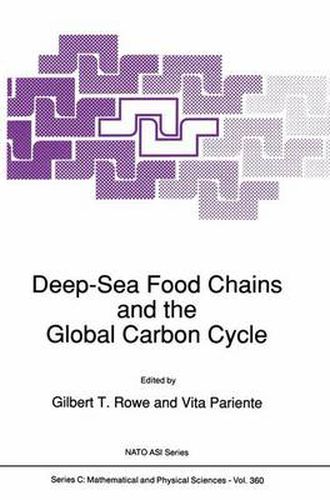Readings Newsletter
Become a Readings Member to make your shopping experience even easier.
Sign in or sign up for free!
You’re not far away from qualifying for FREE standard shipping within Australia
You’ve qualified for FREE standard shipping within Australia
The cart is loading…






Carbon dioxide and other greenhouse gases are increasing in the atmosphere due to the burning of fossil fuels, the destruction of rain forests, etc, leading to predictions of a gradual global warming which will perturb the global biosphere. An important process which counters this trend toward potential climate change is the removal of carbon dioxide from the surface ocean by photosynthesis. This process packages carbon in phytoplankton which enter the food chain or sink into the deep sea. Their ultimate fate is a rain or organic debris out of the surface-mixed layer of the ocean. On a global scale, the mechanisms and overall rate of this process are relatively little known. The authors of the 25 papers in this volume present their state-of-the-art approaches to quantifying the mechanisms by which the rain of biogenic debris nourishes deep ocean life. Prominent deep sea ecologists, geochemists and modellers address relationships between data and models of carbon fluxes and food chains in the deep ocean. An attempt is made to estimate the fate of carbon in the deep sea on a global scale by summing up the utilization of organic matter among all the populations of the abyssal biosphere. Comparisons are made been these ecological approaches and estimates of geochemical fluxes based on sediment trapping, one-dimensional geochemical models and horizontal (physical) input from continental margins. Planning interdisciplinary enterprises between geochemists and ecologists, including new field programmes, are summarized in the final chapter. The summary includes a list of the important gaps in understanding which must addressed before the role of the deep-sea biota in global-scale processes can be put in perspective.
$9.00 standard shipping within Australia
FREE standard shipping within Australia for orders over $100.00
Express & International shipping calculated at checkout
Stock availability can be subject to change without notice. We recommend calling the shop or contacting our online team to check availability of low stock items. Please see our Shopping Online page for more details.
Carbon dioxide and other greenhouse gases are increasing in the atmosphere due to the burning of fossil fuels, the destruction of rain forests, etc, leading to predictions of a gradual global warming which will perturb the global biosphere. An important process which counters this trend toward potential climate change is the removal of carbon dioxide from the surface ocean by photosynthesis. This process packages carbon in phytoplankton which enter the food chain or sink into the deep sea. Their ultimate fate is a rain or organic debris out of the surface-mixed layer of the ocean. On a global scale, the mechanisms and overall rate of this process are relatively little known. The authors of the 25 papers in this volume present their state-of-the-art approaches to quantifying the mechanisms by which the rain of biogenic debris nourishes deep ocean life. Prominent deep sea ecologists, geochemists and modellers address relationships between data and models of carbon fluxes and food chains in the deep ocean. An attempt is made to estimate the fate of carbon in the deep sea on a global scale by summing up the utilization of organic matter among all the populations of the abyssal biosphere. Comparisons are made been these ecological approaches and estimates of geochemical fluxes based on sediment trapping, one-dimensional geochemical models and horizontal (physical) input from continental margins. Planning interdisciplinary enterprises between geochemists and ecologists, including new field programmes, are summarized in the final chapter. The summary includes a list of the important gaps in understanding which must addressed before the role of the deep-sea biota in global-scale processes can be put in perspective.